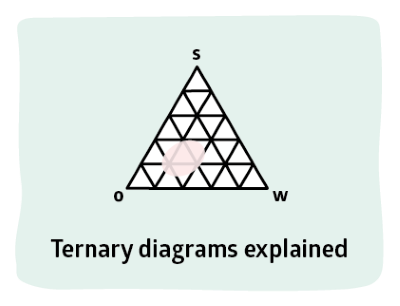PDE: Paths and 1 Phase
Quick Start
One of the formulation challenges in surfactants is to steer a path through phase diagram space without bumping into some awful phase.
Here we see how such navigation works in principle.
PDE1
 You are now an expert in reading phase diagrams. Let's use the Path and Phase functions to look at a typical formulation problem. To help focus on the essentials, most of the fancy options have been removed and we focus on a W,S,X formulation where X might be an oil or a polymer. The goal here is a typical 2-step method that is frequently found necessary for real production of shampoos, detergents etc.:
You are now an expert in reading phase diagrams. Let's use the Path and Phase functions to look at a typical formulation problem. To help focus on the essentials, most of the fancy options have been removed and we focus on a W,S,X formulation where X might be an oil or a polymer. The goal here is a typical 2-step method that is frequently found necessary for real production of shampoos, detergents etc.:
- Create a Premix c from components a and b
- Create the final product from c and another component d
- Using the same "click" as before to set up a phase (with its given radius) somewhere in the triangle you can learn how to formulate around problems where it's not possible to go straight from one mix (e.g. S+X) to the target mix (e.g. S+X+W) via a single dilution (in this case with W) because the intervening phase is too viscous (e.g. a lamellar phase) or forces a split (a 2-phase region).
- Define your original mix from Wa, Sa, Xa and Wb, Sb, Xb, using the slider to alter the proportions, producing an intermediate, c, at Wc, Sc, Xc. As you are entering the mix the total won't necessarily add to 100% but the relative proportions are always scaled to 100% in the calculation to give some reasonable result. Don't pay much attention to the results till the background colours are all change from light red to normal when the total is close to 100%.
- Now define a further mix, Wd, Sd, Xd which is added to Premix c in proportions that can be altered with the slider.
- The result, shown in WT, ST, XT is, you hope, your Target. The path created by these mixes is shown via the arrow. In general, the various WSX blends will tend to be simple mixes along the edge, i.e. involving only one or two components, but the process is entirely general if you believe you can create each of the mixes without going through some bad phase region.
To repeat, the 2-Step mixing process is:
- Step 1 Create an Premix c from the a and b formulations and varying the a:b ratio
- Step 2 Using d (usually as a diluent) plus the Premix c get to the target by bypassing the phase region
In the app it takes some time and experimentation to get used to this way of making blends to avoid phase problems. Imagine, then, the difficulty of doing it in real life, especially if you don't have a handy app to guide you in the process.
Now you have mastered 1-phase systems it's time to move on to the delights of 2-Phase regions.


